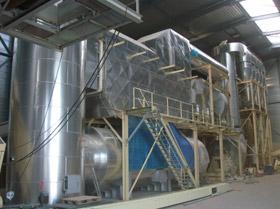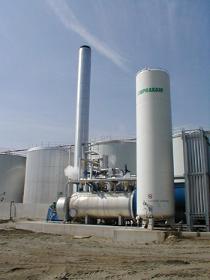- europages
- >
- COMPANIES - SUPPLIERS - SERVICE PROVIDERS
- >
- all co
Results for
All co - Import export

EUROPEM
Belgium
A Redu-reox incinerator features three reaction chambers for the low NOx combustion of waste streams and fuels with a high organically bound Nitrogen content. In the first reaction chamber a reducing environment is maintained to ensure that any free Oxygen will react with Hydrogen to form water. No Oxygen is left to combine with Nitrogen to form NOx. Complete combustion is achieved in the re-oxidation chamber, after the gases have been cooled in the quench stage. The temperature in the re-oxidation chamber is below 950°C to ensure that any Oxygen reacts with Carbon and Hydrogen and not Nitrogen, to minimize formation of thermal NOx. Key Features Three reaction chambers with staged combustion and intermediate flue gas cooling. First chamber operating under a reducing atmosphere at a temperature above 1250oC. Second chamber to quench the flue gases to about 800°C by either injection of steam or recirculated flue gas. Third or re-oxidation chamber for the post-combustion of remaining waste components at temperatures above 900oC. Key Advantages - Ultra-low NOx combustion of waste streams with high bound Nitrogen contents. – Complete oxidation with all hydrocarbons destroyed – No CO formation – Complete odour destruction – No need for SNCR or SCR deNOx to meet emission limits – Destruction efficiency over 99.999%
Request for a quote
EUROPEM
Belgium
A LedeNOx incinerator is an oxidisation-reduction reactor and is the ideal design to achieve low NOx emissions whilst burning waste streams that contain Ammonia and bound Nitrogen. Part of the waste stream containing Ammonia is oxidised and forms NOx in the process. This NOx is then reduced by injecting the remaining Ammonia rich waste stream, where the Ammonia is used to promote a non-catalytic deNOx reaction and reduce NOx to Nitrogen and water. Key Features One combustion chamber with two mixing walls Part of the Ammonia containing waste is injected through the burner, part between the mixing walls. Part of the Ammonia is oxidised to form NOx, whilst the remaining Ammonia is used to react with NOx to form N2. The mixing walls ensure that the waste and combustion gases are mixed and also ensures a uniform temperature profile to improve the overall efficiency of the deNOx reaction. Key Advantages No need for SNCR or SCR deNOx to meet emission limits Ultra-low NOx combustion of waste streams with high bound Nitrogen or Ammonia contents. Complete oxidisation and destruction of all hydrocarbons No CO formation Complete odour destruction Destruction efficiency over 99.999%
Request for a quote
EUROPEM
Belgium
The HI Incinerator features a combustion chamber with a mixing wall which divides this chamber into a high temperature combustion HI zone and a lower temperature post-combustion zone. This particular configuration is most suited to the fuel efficient combustion of lean waste gases and effluents, as it reduces the need for any support fuel. Key Features - Combustion chamber with mixing wall – High intensity combustion zone at elevated temperatures – Waste gases and liquids are delivered to the HI zone through the burner and a series of injection lances. – The mixing wall creates a high temperature zone around flame ensuring complete oxidisation and also to increase turbulence, thus avoiding cold spots and the formation of CO – Post-combustion zone after the mixing wall to ensure residence time of 2 seconds at >850°C Key Advantages - All hydrocarbons are destroyed – No CO formation – Complete odour destruction – Up to 20% fuel saving – Destruction efficiency over 99.99%
Request for a quote
«O2 CONSULTING» LLC
Russia
O2 Consulting provides legal support in bankruptcy, on the side of any participant and across all stages. Not only do we provide legal assistance during arbitral proceedings as such, we undertake to fulfil any incidental tasks, including ones related to the reorganisation process and contesting transfer of the debtor’s assets prior to commencement of the bankruptcy proceedings. We represent clients’ interests in reorganisation transactions related to insolvency and bankruptcy, not only in Russia but also in other jurisdictions. In this case, we undertake to resolve all matters pertaining to co-ordinations with our partner law firms practising in relevant jurisdictions. We also provide assistance to our clients who wish to enter into a transaction with a financially distressed company, structuring the transaction in a way that mitigates the risks related to this company’s future insolvency or bankruptcy. We provide legal support to our clients in transactions with...
Request for a quote
EUROPEM
Belgium
A SRU incinerator is an oxidation-reduction reactor for the recovery of elemental Sulphur from H2S rich waste gases. The first stage of the so called Claus process, is the complete free flame oxidisation of typically 1/3 of the H2S to SO2 in a reaction furnace (H2S + 1½ O SO2 + H2O). The SO2 and the then remaining H2S undergo the Claus reaction both in the reaction furnace and in a series of catalytic reactors (2 H2S + SO2 3S + 2 H2O) resulting in the overall chemical reaction H2S + ½ O H2 + S. Key Features One combustion chamber with mixing wall Part of the waste containing H2S is injected through the burner, the remainder before the mixing wall. The burner is a robust Multifuel design suitable for the combined combustion of different waste gas and gaseous or liquid support fuel streams. The mixing wall ensure the waste and combustion gases combine and also ensures a uniform temperature profile to improve the overall efficiency of the reaction. Key Advantages - Sulphur recovery – Ultra-low NOx combustion possible – Complete oxidisation of all hydrocarbons – No CO formation – Complete odour destruction – Destruction efficiency over 99.99% – For waste air/gas streams containing a high percentage of H2S
Request for a quoteDo you sell or make similar products?
Sign up to europages and have your products listed
POUGET
France
USE : Compulsory Protection for Operating Agents on track, it provides warning of the arrival of train on adjacent track, running at normal Speed. ADVANTAGES : Highly Safe and Efficient Equipment. ( CO MPULSORY for all Track Works ) * 1 tone Manual Warning Signal (V.A. Model) - Ref. 1034-1 - Sound Power = 110 dB to 5 m - Frequency = 388 Hz - Operating Pressure = from 3 to 8 bars - Tank Capacity = 8 Litres The Complete Device includes : - 1 Hand Pump - 1 Air Tank with pressure Gauge - 1 Call Button - 1 Transport Rubber Wheel - Paint yellow varnish - Weight = 16 Kg * 2 tones Manual Warning Signal - Ref. 1034-2 OTHERS WARNING SIGNALS * Lightweight Warning Signal Type T : - With Direct Operating Lever - Sound Power 118 db to 5 m - Paint yellow varnish - Weight = 7 Kg * Warning with Gaz - Ref. AVP - Sound Power : 113 db to 3 m / 110 db to 5 m - Weight = 0.5 Kg * Horn (Type SNCF) - Ref. 1038 - Weight = 0.3 Kg This Material is part of Set of Security - SEC-1
Request for a quoteResults for
All co - Import exportNumber of results
7 ProductsCountries
Company type
Category